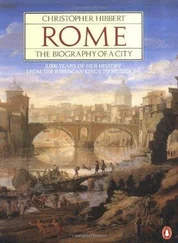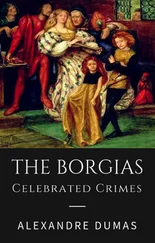Having finished their tour of inspection in Piombino, the pope proposed to his companions to take a day sailing around the coast ‘to amuse themselves.’ Unfortunately, an unexpected storm blew up, as sometimes happens in the Tyrrhenian Sea, making it impossibly dangerous for them to reenter the harbour at Piombino and forcing them to spend the next few nights at sea. On the fourth day the storm had worsened, bringing huge breakers crashing over the bows of their boats, and Cesare, ‘fearing great danger,’ risked his own life by leaving the galley in a small boat to row ashore to get help.
Then, according to Burchard, who recounted what he had heard from the survivors:
The Pope stayed on the galley, unable to put into port. His companions, paralysed by fear, lay stretched out in the bottom of the boat; only His Holiness, seated on the poop, kept a resolute and brave stand. When the sea pounded the boat with anger, he cried ‘Jesus!’ and made the sign of the cross and told the sailors to get on with preparing the meal. But they replied that the crashing waves and the roaring wind prevented them from lighting a fire. Finally the sea grew calmer and it was possible to fry fish for the Pope to eat.
Back in Rome a few days later, the pope and Cesare turned their thoughts to the next stage of the expansion of the duchy of Romagna and to the raising of the large sums of money required to prosecute it. With the northern border of the duchy secured by the marriage of Lucrezia to Alfonso d’Este, Cesare set his sights on two small papal fiefs, Camerino and Senigallia; more covertly, father and son had plotted a far more ambitious scheme to seize the much larger fiefs of Urbino and Bologna and also to expand into Tuscany by fomenting rebellion in Arezzo and Pisa, two cities that much resented their subjugation to republican Florence.
With this campaign in mind, it was at about this time, in the summer of 1502, that Cesare appointed Leonardo da Vinci as his ‘Architect and General Engineer’ and, as such, instructed him to ‘survey the strongholds and fortresses’ of his territories. By this commission Leonardo was to be exempt from ‘all public toll for himself and his company’ and to be given free access to ‘see, measure and estimate all that he may wish.’
Leonardo, whose Last Supper in the convent of Santa Maria delle Grazie in Milan was so much admired by Louis XII, had been employed as a military engineer by the luckless Duke Ludovico Sforza since he was a painter. For Cesare he drew maps, proposed systems of defence works, and designed a canal connecting Cesena with the port of Cesenatico. For ten months he travelled across the Papal States, clearly fascinated by the character and ambitions of his gifted and mysterious employer; several maps survive among Leonardo’s papers, including one showing the approaches to Arezzo.
By the beginning of June, Alexander VI and Cesare had laid their plans. By coincidence, a new ambassador arrived from Venice at about the same time; this was Antonio Giustinian, whose perceptive and illuminating dispatches were to keep the Venetian government as well informed about papal affairs as could be expected. His task, however, was hampered by Cesare, who, he reported, continued to clothe his intentions behind a curtain of secrecy and declined to give a date when he could spare time to see the envoy.
In one of his first dispatches, Giustinian reported that there were differences between Alexander VI and his son, especially regarding money. ‘Today the Pope has had some difficulties with the Duke, who requires another 20,000 ducats for his campaign, for which His Holiness has already paid a great deal,’ he wrote, before coming to the conclusion that ‘although the Pope is reluctant to give him the money, he will come round in the end, as he does with everything concerning his son.’
In the end Giustinian did not have to wait long for the nature of Cesare’s plans to be revealed. On June 5, within days of the envoy’s arrival, news came through of a riot against the unpopular Florentine government in Arezzo, outside which Cesare’s trusted condottiere Vitellozzo Vitelli and an army of three thousand men awaited orders; Vitelli entered the city two days later, where he was joined by another of Cesare’s captains, Gianpaolo Baglioni. Almost immediately, news also arrived of a successful uprising in Pisa, and the city offered its allegiance to Cesare. Four days later Burchard noted that ‘the corpse of Astorre Manfredi, Lord of Faenza,’ who had been overthrown by Cesare after a long siege the previous year and imprisoned in Castel Sant’Angelo, ‘has been fished out of the Tiber, drowned by a stone tied round his neck.’ The master of ceremonies lamented his death: ‘This young man, just 18 years old, was of such beauty and stature that it would not be possible to find his equal among a thousand of his contemporaries.’
Although both Alexander VI and Cesare vigorously denied any involvement in the taking of Arezzo, protesting instead that Vitelli had acted upon his own initiative, few in Rome believed them. And it was generally accepted that the murder of Manfredi was also committed on the orders of Cesare, who was anxious to avoid any trouble from the supporters of the popular Astorre while he was away from Rome with his army.
A few days later Cesare was at Spoleto with his army of six thousand infantry and two thousand cavalry, and his condottieri captains, the Spaniards Ugo de Moncada and Miguel de Corella, and the Italians Paolo Orsini and his cousin Francesco, the Duke of Gravina; Oliverotto Euffreducci, Lord of Fermo; Gianpaolo Baglioni, Lord of Perugia; and Vitellozzo Vitelli, Lord of Città di Castello, who had reluctantly submitted to Cesare’s request to withdraw from Arezzo. Massing in the Romagna, meanwhile, another army, led by Cesare’s governor, Ramiro de Lorqua, prepared to move south.
There was at first some doubt in Rome as to where these armies were marching; some said Pisa, others Arezzo, though most assumed that their destination was Camerino, the state of Giulio Cesare da Varano, who had been excommunicated by Alexander VI on June 5 on a charge of fratricide. To this end, the Duke of Urbino had given permission for Ramiro de Lorqua and the Romagna troops to pass through his state; though he had also, unwisely as it was to turn out, offered help to Varano to defend Camerino.
In fact, Cesare was about to attempt a highly ambitious coup and seize Urbino itself, with its commanding position between the Romagna and Rome; and to justify this unprovoked attack by claiming that the duke, Guidobaldo de Montefeltro, had acted treasonably in his offer to assist Varano.
The Duke of Urbino, meanwhile, believing Cesare to be many miles away to the south and having no reason to doubt his protestations of friendship, had gone to enjoy an alfresco dinner in the park of a monastery just outside the walls of his capital. In the middle of the meal, a courier was observed riding at speed into the park with an urgent message: Cesare’s troops were marching on Urbino itself; they were less than twenty miles away. Guidobaldo fled and, evading Cesare’s troops who had been ordered to intercept him, he arrived, dishevelled and exhausted, in Mantua a week later.
The exiled Guidobaldo da Montefeltro did, however, retain his dignity, refusing the offer of a cardinal’s hat and a pension in exchange for his rights to the dukedom of Urbino. To humiliate the duke still further, it was revealed at this time that he was impotent, a misfortune that had remained a secret outside the family for years. Still, his loyal wife, Elisabetta, declared that she would rather live with him as his sister than no longer as his wife.
In an attempt to negotiate the restoration of their authority in Arezzo, the Florentines now sent to Urbino a high-ranking delegation led by Francesco Soderini, bishop of Volterra and brother to the head of the Florentine republic, which was required to report on the situation to the government back home. The secretary to this delegation was none other than Niccolò Machiavelli, who was deeply impressed with Cesare, so much so in fact that his enemies would later claim that the secretary had been bribed by the duke, though no evidence has ever emerged to support these rumours.
Читать дальше











